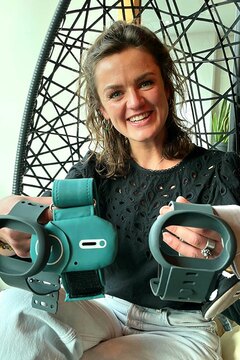Internal study on wearing comfort of viQtor completed
“Ultimately, we want to develop the perfect bracelet”
Lotte Giele, assistent clinical affairs
When you see what advanced technology is hidden in our viQtor, the bracelet in which it is worn seems only of secondary importance. Yet that very bracelet can make all the difference. That is why Lotte Giele, our assistant in clinical affairs, is conducting internal studies that will allow us to improve the wearing comfort and functionality of this bracelet.
 "Wearability is a super important part of viQtor. Before, our main focus was on developing new algorithms and adding new features. But from the pilots we did, we received valuable feedback from users. These showed that the comfort of the bracelet that the monitoring device is worn on the arm is essential. The device can work so well, but if the bracelet is uncomfortable, itches or irritates your skin, you won't wear it."
"Wearability is a super important part of viQtor. Before, our main focus was on developing new algorithms and adding new features. But from the pilots we did, we received valuable feedback from users. These showed that the comfort of the bracelet that the monitoring device is worn on the arm is essential. The device can work so well, but if the bracelet is uncomfortable, itches or irritates your skin, you won't wear it."
Bracelet made of silicone
The first version of the bracelet, the Dartex bracelet that closes with Velcro, proved not to give the desired comfort to some wearers. Therefore, a new bracelet was developed, made of silicone. "That silicone band can be compared to the bands of smartwatches you see a lot nowadays. It closes with two push buttons. We know that silicone is well tolerated on the skin. But the contact surface is larger for viQtor than say, for a watch. Also, the band is worn in a different location (around the upper arm instead of the wrist) and the weight is a bit heavier. So you have to investigate whether that might cause different skin reactions."
New insights
Lotte asked eleven colleagues to test the band for a while. "I myself also wore it, also because I wanted to experience for myself the product we are promoting. It took me a few days to get used to it, the first days I really noticed that there was something on my arm. You have to get some routine into it. As the study progressed I noticed that I forgot more and more about it, more colleagues did. That's a good sign. We did notice that it can be difficult to fasten the push buttons with one hand. So we need to develop that further. I would like to thank all colleagues who participated in this study. Thanks in part to them, we have new insights that we can move forward with."
Comfortable and reliable
The internal study that Lotte designed and conducted had two goals that were almost unrelated: to improve the wearing comfort of the bracelet and to test the functionality of the device. "We don't just want a comfortable bracelet, we also want the data to enter the viQtor portal properly. The moment a parameter fails, or the device is detected as 'not being worn' when it is, we investigate what causes this. Then we look at what the next steps might be to fix the problem."
Follow-up studies in the pipeline
Now that this internal study has been completed, the next one is soon in the pipeline. "There are already two new bracelets coming. One is an improved version of the ostomy band, made of elastic. The silicone band will also be improved; the casing will be thicker and sturdier and will have flaps so that the device cannot fall out. Again, we are going to test these models extensively internally before using them externally in the field. This is how we ultimately want to develop the perfect bracelet."
Opportunities for improvement
Conducting these clinical studies is right up Lotte's alley. After earning her bachelor's degree in Nursing, she studied Health Sciences at the VU University of Amsterdam. "The overarching picture appeals to me more than actually being at the bedside. I once said: if I could ever make another career switch, I would choose dermatology. How funny is it that everything is coming together right now!
I find it extremely interesting to be involved in this research, it gives me a lot of energy. We are making good progress, but there is certainly still room for improvement. The test group now consisted of young, healthy people, but the patient population that will use it is of course different. For example, some patients have an extremely sensitive skin. In the future, we might be able to offer customized bracelets, those are hypotheses we have now. So there is still plenty to do!"